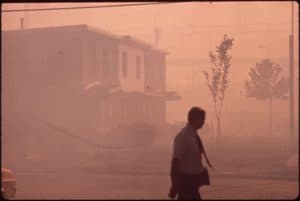
Credit: U.S. National Archives and Records Administration
In November 1971 the residents of Birmingham, Ala., feared for their lives when an atmospheric phenomenon known as an “inversion” trapped and concentrated industrial air pollutants in the city. Its residents were no strangers to industry’s air pollution—there are stories of people changing their white shirts after arriving at their offices because the shirts had turned black on the brief walk to work. This was the worst air pollution event residents had ever seen; Birmingham found itself in a health crisis.
The Jefferson County Health Department formally requested 23 major emitters of air pollution in Birmingham to reduce their emissions by 60 percent. This request went largely ignored, particularly by the largest emitters in the city. In the absence of state and local legal options the Environmental Protection Agency (EPA) stepped in and for the first time in the federal agency’s history. It invoked emergency powers under the Clean Air Act to take enforcement action to abate air pollution. In the following days a combination of […]










